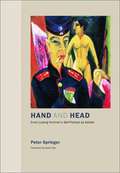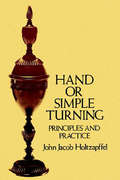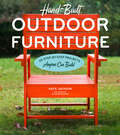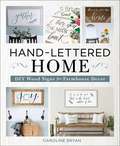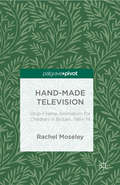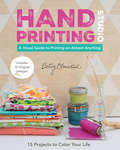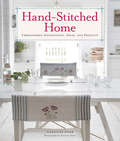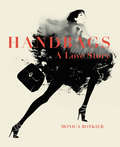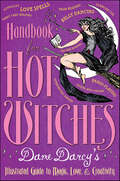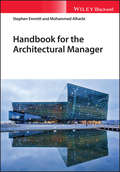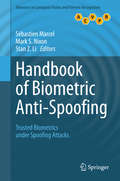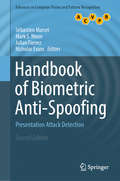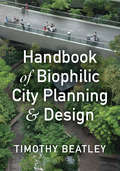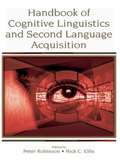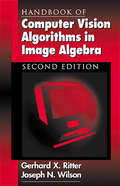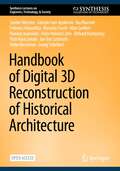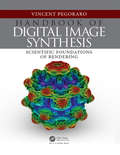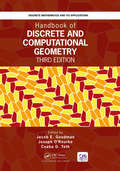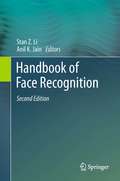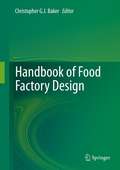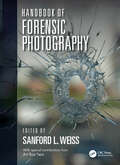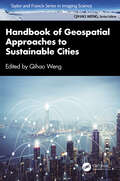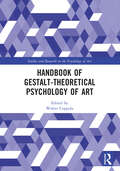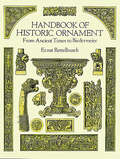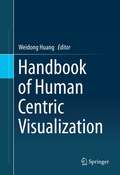- Table View
- List View
Hand and Head: Ernst Ludwig Kirchner's Self-Portrait as Soldier
by Peter SpringerErnst Ludwig Kirchner's Self-Portrait as Soldier is one of the best-known self-portraits of the modern classical period. With its sharp foreground focus on the uniformed artist's bloody amputated hand, the painting has long been interpreted as a vehement protest against war, specifically World War I and Kirchner's participation in it.
Hand or Simple Turning: Principles and Practice (Dover Woodworking Ser.)
by John Jacob HoltzapffelGreat Victorian classic offers full coverage of basic lathe techniques: history and development, special apparatus, softwood turning, hardwood turning, metal turning, more. Projects include billiard ball, egg cups, ash trays, vases, jardiniers, others. First inexpensive paperback reprint.
Hand-Built Outdoor Furniture: 20 Step-by-Step Projects Anyone Can Build
by Katie Jackson Ellen BlackmarSelected as a Gardens Illustrated Recommended ReadHand-Built Outdoor Furniture covers twenty step-by-step, fully illustrated projects with hundreds of clear and easy-to-follow photographs. Finished pieces include simple items include a trellis, a flower box, and a plant stand and more complicated projects include a chaise lounge, a sectional with built-in storage, and a slat bench. Katie Jackson's projects are simple, clean, and timeless and work well within a wide variety of styles. Hand-Built Outdoor Furniture is the perfect primer for people new to woodworking, DIYers, and homeowners looking for a simple and affordable to decorate their space.
Hand-Lettered Home: DIY Wood Signs for Farmhouse Decor
by Caroline BryanYou can create your own lettering art to personalize your wall decor and add modern farmhouse style to every area of your home. Even if you’re new to hand lettering, you’ll find it easier than you ever imagined with Caroline Bryan's Hand-Lettered Home. -Learn the art of hand lettering with 20 beautiful projects.-Get expert tips on the best lettering tools and techniques. -Practice pages make it simple to learn a variety of lettering styles.-Step-by-step instructions guide you to create gorgeous signs.-Nurture your creativity with design variations for every project.-Craft one-of-a-kind gifts for loved ones.You’ll treasure the meaning and memories hand-lettered signs capture for you and your family!
Hand-Made Television: Stop-Frame Animation for Children in Britain, 1961-1974
by R. MoseleyHand-Made Television explores the ongoing enchantment of many of the much-loved stop-frame children's television programmes of 1960s and 1970s Britain. The first academic work to analyse programmes such as Pogles' Wood (1966), Clangers (1969), Bagpuss (1974) (Smallfilms) and Gordon Murray's Camberwick Green (1966), Trumpton (1967) and Chigley (1969), the book connects these series to their social and historical contexts while providing in-depth analyses of their themes and hand-made aesthetics. Hand-Made Television shows that the appeal of these programmes is rooted not only in their participatory address and evocation of a pastoral English past, but also in the connection of their stop-frame aesthetics to the actions of childhood play. This book makes a significant contribution to both Animation Studies and Television Studies; combining scholarly rigour with an accessible style, it is suitable for scholars as well as fans of these iconic British children's programmes.
Hand-Printing Studio: A Visual Guide to Printing on Almost Anything
by Betsy OlmstedThis DIY guide to hand-printing lets you put your designs on almost anything—from fabric, glass, and wood to human beings and more!Print artist and textile designer Betsy Olmsted shares her love of art through her namesake brand. Now she shares her tips and techniques with 15 colorful projects you can try at home—from a galvanized planter and curtains to a coffee table. With this step-by-step visual guide, you will earn to add your own design to nearly any surface with block printing, silk screen, and disperse dye transfer. Betsy gets you started with 12 charming patterns, plus inspiration for creating your own designs!
Hand-Stitched Home
by Caroline ZoobA Hand-Stitched Home is one in which lovely embroidered designs personalize and enliven the space. These designs can be tiny embroidered details, decorative trims, or large, colorful pictures. In this uniquely beautiful volume, five sections and twenty-four embroidery projects reveal how to turn your living space into an elegant, inviting Hand-Stitched Home. Making PicturesA needle and thread are perfect tools to paint pictures--like a countryside image to adorn bookends or a nautical scene to transform a scrap of fabric into artwork so lovely that it begs to be framed. On the EdgeSimple decorative details can add beauty in the most unexpected of places. A light green print of ivy can embellish the edge of a chair cover, a print of kitchen supplies can makes shelf edging easy on the eyes. At the TableThe kitchen is the heart of the home and the table is the heart of the kitchen. A vibrant pinwheel design makes a stunning tablecloth runner, names or initials on placemats will bring the whole family together at mealtime. The Soft StuffNothing lends itself as easily to embroidery as blankets and pillows. Textured violets on a pillow or bright, scattered flowers on a white quilt fill living rooms and bedrooms with comfort and cheer. At the WindowEmbroidery allows everyday objects to add grace to the home. A white thread design on a sheer curtain or an embroidered pelmet are delightful accessories to guide sunshine into the home.
Handbags: A Love Story
by Monica BotkierIn this sumptuous full-color compendium, award-winning designer Monica Botkier celebrates seventy of the most coveted bags of the past seventy-five years, from Chanel, Dior, Gucci, Hermès, Yves Saint Laurent, Louis Vuitton, and other international couture houses, as well as top bag designers such as Anya Hindmarch and Nancy Gonzalez.Exquisitely crafted luxury handbags are an obsession. The look, the feel of soft leather, that new bag smell that induces a swoon—a gorgeous handbag does more than complete a look, it telegraphs taste and chic, and it inspires envy, whether it’s an Hermès Birkin, a quilted Chanel Boy bag with its signature gold chain, or a Céline Mini Luggage Tote. Award-winning handbag designer Monica Botkier pays homage to these gorgeous objects of desire and the top couture houses and artists that have designed and produced them from the end of World War II to today.Handbags: A Love Story showcases the creations of designers such as Azzedine Alaïa, Balenciaga, Bottega Veneta, Céline, Chanel, Chloé, Christian Dior, Mark Cross, Fendi, Salvatore Ferragamo, Givenchy, Goyard, Gucci, Hermès, Anya Hindmarch, Judith Leiber, Olympia Le-Tan, Loewe, Mansur Gavriel, Stella McCartney, Alexander McQueen, Miu Miu, Moschino, Mulberry, Prada, Yves Saint Laurent, Valentino, Roger Vivier, Louis Vuitton, and more. This magnificent, eye-catching anthology tells the story of seventy bags in 200 stunning photographs and vintage and contemporary advertisements and illustrations, as well as quotes, anecdotes, and interviews with designers, stylists, and editors.Each entry offers a concise yet in-depth look at a specific bag and its history—from a celebrity muse, such as Jane Birkin, to collaborations such as the graffiti-splattered bags Marc Jacobs and Stephen Sprouse created for Louis Vuitton. An informative, entertaining exploration of how "It Bags" have influenced fashion, culture, and feminine identity, Handbags: A Love Story touches on a wide-range of subjects, such as how a bag is constructed and handbags on the silver screen.With an elegant full-color silkscreened cloth case and a thick acetate four-color jacket; two long, wide satin markers, and two-color endpapers, this gorgeous tribute is an essential accessory for handbag fanatics, fashion lovers, and pop culture enthusiasts.
Handbook for Hot Witches: Dame Darcy's Illustrated Guide to Magic, Love, & Creativity
by Dame DarcyCombine a graphic novel with a dash of crafts, a sprinkle of feminist fairy tales, and a whole cauldron of spells—voilà!—Dame Darcy's Handbook for Hot Witches. This is the guide for girls who want cool things to do and great friends to do them with, who aren't afraid to be their different, awesome selves. It's a celebration of powerful, creative girls—the sort of girls who may have been called "witches" once, but who, as this book proclaims, are "hot," because of their talent and their uniqueness. With sections on banjo playing, beauty spells, palm reading, and much more, this fully illustrated handbook will send girls on their way to independence, creativity, and magic.
Handbook for the Architectural Manager
by Stephen Emmitt Mohammed A. AlharbiThe essential resource for becoming more effective in the highly competitive architectural marketplace Handbook for the Architectural Manager offers architects a comprehensive resource that brings together critical information on four interlinked areas: managing the architectural office, projects, stakeholders, and learning. Unlike other books on the topic that only stress management of the business or the management of projects, this book offers a guiding framework that encompasses the architectural manager's role in developing the practice’s competitive strategies and overseeing the project portfolio. Written by noted experts in the field, Handbook for the Architectural Manager is grounded in current research in which, for the first time, the components of architectural management have been analyzed systematically, tested, and developed for practical application. Designed to explore typical architectural management issues, the book provides clear and concise direction with practical step-by-step guidance as well as helpful checklists, templates and scenarios, and case studies to illustrate best practice. This essential resource: Offers a groundbreaking handbook that contains a comprehensive management framework for architectural practice Contains new insights and guidance based on solid research on managing the architectural practice Brings together in one book the best management techniques of the office, projects, stakeholders, and learning Includes a well-grounded critical review of the existing literature on the topic Designed for professionals in the field but written in accessible language suitable for students Handbook for the Architectural Manager offers a practical guide for overseeing the development of architectural designs and associated activities and ensuring all work is consistent (i.e. adheres to current standards, legislation, client specifications, and office protocols) and completed on time as well as information on staff development and learning.
Handbook of Biometric Anti-Spoofing
by Stan Z. Li Sébastien Marcel Mark S. NixonPresenting the first definitive study of the subject, this Handbook of Biometric Anti-Spoofing reviews the state of the art in covert attacks against biometric systems and in deriving countermeasures to these attacks. Topics and features: provides a detailed introduction to the field of biometric anti-spoofing and a thorough review of the associated literature; examines spoofing attacks against five biometric modalities, namely, fingerprints, face, iris, speaker and gait; discusses anti-spoofing measures for multi-model biometric systems; reviews evaluation methodologies, international standards and legal and ethical issues; describes current challenges and suggests directions for future research; presents the latest work from a global selection of experts in the field, including members of the TABULA RASA project.
Handbook of Biometric Anti-Spoofing (Advances in Computer Vision and Pattern Recognition)
by Nicholas Evans Sébastien Marcel Mark S. Nixon Julian FierrezThis authoritative and comprehensive handbook is the definitive work on the current state of the art of Biometric Presentation Attack Detection (PAD) – also known as Biometric Anti-Spoofing. Building on the success of the previous, pioneering edition, this thoroughly updated second edition has been considerably expanded to provide even greater coverage of PAD methods, spanning biometrics systems based on face, fingerprint, iris, voice, vein, and signature recognition. New material is also included on major PAD competitions, important databases for research, and on the impact of recent international legislation. Valuable insights are supplied by a selection of leading experts in the field, complete with results from reproducible research, supported by source code and further information available at an associated website. Topics and features: reviews the latest developments in PAD for fingerprint biometrics, covering optical coherence tomography (OCT) technology, and issues of interoperability; examines methods for PAD in iris recognition systems, and the application of stimulated pupillary light reflex for this purpose; discusses advancements in PAD methods for face recognition-based biometrics, such as research on 3D facial masks and remote photoplethysmography (rPPG); presents a survey of PAD for automatic speaker recognition (ASV), including the use of convolutional neural networks (CNNs), and an overview of relevant databases; describes the results yielded by key competitions on fingerprint liveness detection, iris liveness detection, and software-based face anti-spoofing; provides analyses of PAD in fingervein recognition, online handwritten signature verification, and in biometric technologies on mobile devicesincludes coverage of international standards, the E.U. PSDII and GDPR directives, and on different perspectives on presentation attack evaluation. This text/reference is essential reading for anyone involved in biometric identity verification, be they students, researchers, practitioners, engineers, or technology consultants. Those new to the field will also benefit from a number of introductory chapters, outlining the basics for the most important biometrics.
Handbook of Biophilic City Planning & Design
by Timothy BeatleyWhat if, even in the heart of a densely developed city, people could have meaningful encounters with nature? While parks, street trees, and green roofs are increasingly appreciated for their technical services like stormwater reduction, from a biophilic viewpoint, they also facilitate experiences that contribute to better physical and mental health: natural elements in play areas can lessen children's symptoms of ADHD, and adults who exercise in natural spaces can experience greater reductions in anxiety and blood pressure.The Handbook of Biophilic City Planning & Design offers practical advice and inspiration for ensuring that nature in the city is more than infrastructure--that it also promotes well-being andcreates an emotional connection to the earth among urban residents. Divided into six parts, the Handbook begins by introducing key ideas, literature, and theory about biophilic urbanism. Chapters highlight urban biophilic innovations in more than a dozen global cities. The final part concludes with lessons on how to advance an agenda for urban biophilia and an extensive list of resources.As the most comprehensive reference on the emerging field of biophilic urbanism, the Handbook is essential reading for students and practitioners looking to place nature at the core of their planning and design ideas and encourage what preeminent biologist E.O. Wilson described as "the innate emotional connection of humans to all living things."
Handbook of Cognitive Linguistics and Second Language Acquisition
by Peter Robinson Nick C. EllisThis cutting-edge volume describes the implications of Cognitive Linguistics for the study of second language acquisition (SLA). The first two sections identify theoretical and empirical strands of Cognitive Linguistics, presenting them as a coherent whole. The third section discusses the relevance of Cognitive Linguistics to SLA and defines a research agenda linking these fields with implications for language instruction. Its comprehensive range and tutorial-style chapters make this handbook a valuable resource for students and researchers alike.
Handbook of Computer Vision Algorithms in Image Algebra
by Joseph N. Wilson Gerhard X. RitterImage algebra is a comprehensive, unifying theory of image transformations, image analysis, and image understanding. In 1996, the bestselling first edition of the Handbook of Computer Vision Algorithms in Image Algebra introduced engineers, scientists, and students to this powerful tool, its basic concepts, and its use in the concise representation
Handbook of Digital 3D Reconstruction of Historical Architecture (Synthesis Lectures on Engineers, Technology, & Society #28)
by Sander Münster Piotr Kuroczyński Marinos Ioannides Heike Messemer Fabrizio Ivan Apollonio Ina Bluemel Federico Fallavollita Riccardo Foschi Marc Grellert Peter Heinrich Jahn Richard Kurdiovsky Jan-Eric Lutteroth Georg SchelbertThis open access book is a handbook for students, experts and interested parties who want to learn more about digital 3D reconstruction of historical architecture. The book provides answers to the core questions of the subject: What is a digital 3D model or a digital 3D reconstruction? How are they created and what are they used for? Practical instructions, condensed knowledge, explanations of technical terms and references to example projects, literature and further references provide information of varying density and thus enable an individual introduction to the subject.The book combines extensive knowledge on the topic of "digital 3D reconstruction of historical architecture" and provides practical instructions for independent implementation. Up to now, there has been no cross-disciplinary vocabulary for technical terms in this field, so this publication makes a start.The book is aimed at students, experts in the field and the interested public and offers various possibilities for the different target groups to delve deeply into the subject.The book was created within the research network "Digital 3D Reconstruction as Tools for Research in Architectural History," which was funded by the German Research Foundation (DFG) from 2018 to 2023. The authors combined their expertise in the fields of art and architectural history, architecture, university teaching and media informatics.
Handbook of Digital Image Synthesis: Scientific Foundations of Rendering
by Vincent PegoraroThe Handbook of Digital Image Synthesis is the most up-to-date reference guide in the rapidly developing field of computer graphics. A wide range of topics, such as, applied mathematics, data structures, and optical perception and imaging help to provide a well-rounded view of the necessary formulas for computer rendering. In addition to this diverse approach, the presentation of the material is substantiated by numerous figures and computer-generated images. From basic principles to advanced theories, this book, provides the reader with a strong foundation of computer formulas and rendering through a step-by-step process. . Key Features: Provides unified coverage of the broad range of fundamental topics in rendering Gives in-depth treatment of the basic and advanced concepts in each topic Presents a step-by-step derivation of the theoretical results needed for implementation Illustrates the concepts with numerous figures and computer-generated images Illustrates the core algorithms using platform-independent pseudo-code
Handbook of Discrete and Computational Geometry (Discrete Mathematics and Its Applications)
by Jacob E. Goodman Csaba D. Tóth Joseph O’RourkeThe Handbook of Discrete and Computational Geometry is intended as a reference book fully accessible to nonspecialists as well as specialists, covering all major aspects of both fields.The book offers the most important results and methods in discrete and computational geometry to those who use them in their work, both in the academic world—as researchers in mathematics and computer science—and in the professional world—as practitioners in fields as diverse as operations research, molecular biology and robotics.Discrete geometry has contributed significantly to the growth of discrete mathematics in recent years. This has been fueled partly by the advent of powerful computers and by the recent explosion of activity in the relatively young field of computational geometry. This synthesis between discrete and computational geometry lies at the heart of this Handbook.A growing list of application fields includes combinatorial optimization, computer-aided design, computer graphics, crystallography, data analysis, error-correcting codes, geographic information systems, motion planning, operations research, pattern recognition, robotics, solid modeling, and tomography.
Handbook of Face Recognition
by Stan Z. Li Anil K. JainThis highly anticipated new edition provides a comprehensive account of face recognition research and technology, spanning the full range of topics needed for designing operational face recognition systems. After a thorough introductory chapter, each of the following chapters focus on a specific topic, reviewing background information, up-to-date techniques, and recent results, as well as offering challenges and future directions. Features: fully updated, revised and expanded, covering the entire spectrum of concepts, methods, and algorithms for automated face detection and recognition systems; provides comprehensive coverage of face detection, tracking, alignment, feature extraction, and recognition technologies, and issues in evaluation, systems, security, and applications; contains numerous step-by-step algorithms; describes a broad range of applications; presents contributions from an international selection of experts; integrates numerous supporting graphs, tables, charts, and performance data.
Handbook of Food Factory Design
by Christopher G. BakerFood manufacturing has evolved over the centuries from kitchen industries to modern, sophisticated production operations. A typical food factory includes the food processing and packaging lines, the buildings and exterior landscaping, and the utility-supply and waste-treatment facilities. As a single individual is unlikely to possess all the necessary skills required to facilitate the design, the task will undoubtedly be undertaken by an interdisciplinary team employing a holistic approach based on a knowledge of the natural and biological sciences, most engineering disciplines, and relevant legislation. In addition, every successful project requires a competent project manager to ensure that all tasks are completed on time and within budget. This Handbook attempts to compress comprehensive, up-to-date coverage of these areas into a single volume. It is hoped that it will prove to be of value across the food-manufacturing community. The multi-disciplinary nature of the subject matter should facilitate more informed communication between individual specialists on the team. It should also provide useful background information on food factory design for a wider range of professionals with a more peripheral interest in the subject: for example, process plant suppliers, contractors, HSE specialists, retailers, consultants, and financial institutions. Finally, it is hoped that it will also prove to be a valuable reference for students and instructors in the areas of food technology, chemical engineering, and mechanical engineering, in particular.
Handbook of Forensic Photography
by Sanford L WeissHandbook of Forensic Photography is the most-comprehensive, definitive reference for the use of photography in the capture and presentation of forensic evidence. The intent is to inform the reader about the most complete and up-to-date methods to capture and reproduce images that most accurately represent the evidence. With the rise in importance of forensic science, crime and accident scene documentation has likewise increased in importance—not the least of which has been forensic photography. The need to use accepted practice and protocols to guarantee the authenticity of images for evidence documentation is paramount for using it in court. And as with any discipline, there is an art to the science of forensic photography. Contributing authors from various backgrounds—each experts in their field—have provided numerous case examples, best practices, and recommendations for recognizing, recording, and preserving evidence using cameras and the latest digital image technology, including video and other imaging technologies. Chapters present such topics as videography, drone photography, underwater photography, crime scene photography, autopsy photographs, fire documentation, forensic odontology, and more. The book closes with coverage of courtroom displays, presenting imaging evidence and expert witness testimony in the courtroom. Handbook of Forensic Photography is a must-have reference for experienced crime scene photographers, death and crime scene investigators, police, and forensic professionals—including medical examiners, odontologists, engineers, and forensic anthropologists—who frequently need to capture investigative photographs in the course of investigations.
Handbook of Geospatial Approaches to Sustainable Cities (Imaging Science)
by Qihao Weng Cheolhee YooThis comprehensive handbook presents the current state of knowledge on geospatial technologies, techniques, and methods that are imperative for providing solutions to sustainable cities. It addresses the role of geospatial big data and AI techniques and how they are applied when analyzing the sustainability of urban development, land use, urban planning, and resource management, as well as monitoring the impact urbanization has on the environment and the ecosystem. Taking an interdisciplinary approach to sustainable cities, and with contributions from renowned experts around the world, this holistic handbook is a toolbox for geospatial, urban, and sustainability professionals, the artificial intelligence community, and those who work in related fields. Features: Explores cutting-edge geospatial and AI techniques in support of efficient, resilient, digital, and smart cities Bridges urban science and sustainability science via geospatial methods Contributes to the efforts of GEO by addressing and exemplifying pertinent societal benefit areas and engagement priorities Includes 16 case studies with a broad geographic scope that integrate societal needs with technological advances Draws expertise in geospatial technology, big data, and artificial intelligence from leading experts in the world This book is intended for researchers and scientists interested in learning techniques in GeoAI, including the technologies for collecting, analyzing, managing, processing, and visualizing geospatial datasets.
Handbook of Gestalt-Theoretical Psychology of Art (Studies and Research in the Psychology of Art)
by Walter CoppolaThe Handbook of Gestalt-Theoretic Psychology of Art synthesizes contemporary research in the psychology of perception, cognition, language and hearing to reassess the Gestalt approach to studying the arts.Since Rudolf Arnheim’s death in 2007, the field has seen a resurgence, with scientists revisiting and reinventing previously articulated points of view. For the first time, this new work is gathered in a single comprehensive resource. Beginning with a history of the field, the book considers meta-theoretic issues before discussing the various senses. It explores topics including aesthetics, space, poetry, literature, music, and film, bringing together leading researchers from across the discipline.It will be an essential read for all students and researchers of the psychology of art, the psychology of perception, or Gestalt Theory.
Handbook of Historic Ornament (Dover Pictorial Archive)
by Ernst RettelbuschClassic resource contains over 1,200 examples of ornamental and decorative design produced by many cultures over five millennia. Assyrian, Greek, Roman, Byzantine; European Renaissance, Baroque, Rococo; English furniture designs by Chippendale, Sheraton and Hepplewhite; French Empire; Nordic motifs; Chinese and Japanese material, much more. Royalty-free. 254 plates.
Handbook of Human Centric Visualization
by Weidong HuangVisualizations are visual representations of non-visual data. They are produced for people to interact with and to make sense of the underlying data. Rapid advances in display technology and computer power have enabled researchers to produce visually appealing pictures. However, the effectiveness of those pictures in conveying the embedded information to end users has not been fully explored. Handbook of Human Centric Visualization addresses issues related to design, evaluation and application of visualizations. Topics include visualization theories, design principles, evaluation methods and metrics, human factors, interaction methods and case studies. This cutting-edge book includes contributions from well-established researchers worldwide, from diverse disciplines including psychology, visualization and human-computer interaction. This handbook is designed for a professional audience composed of practitioners, lecturers and researchers working in the field of computer graphics, visualization, human-computer interaction and psychology. Undergraduate and postgraduate students in science and engineering focused on this topic will also find this book useful as a comprehensive textbook or reference.
